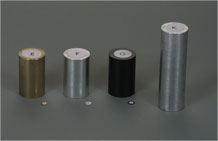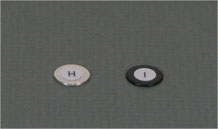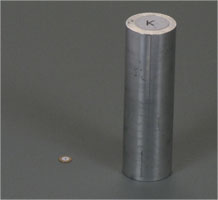Distinguishing heavier from heavier kind of material
In the second density task, children are first allowed to compare the weights of three (uncovered) same-size cylinders made of brass, aluminum, and Delrin (a hard black plastic). They learn and can see for themselves that brass is a heavier kind of material than aluminum, which is a heavier material than Delrin.
They are then shown different amounts of these same materials and asked to answer questions about the heaviness of the materials. If they comprehend that a material’s heaviness does not depend on how much is present, their judgments should be consistent with what they had just learned. If, on the other hand, they did not clearly distinguish between weight and heaviness of material, an object’s weight would interfere with their judgments of heaviness of material.




Figure 9: The cylinders used in this task and the three critical comparisons: (a) all the cylinders; (b) the small (same size) slivers of aluminum and Delrin (which are both light and indistinguishable in felt weight); (c) the small (light) sliver of brass and the large (much heavier) chunk of aluminum; and (d) a small and large piece of aluminum.
In their first interview at the beginning of grade 3, children tended to focus simply on the weight or felt weight of the specific object pairs; fewer than 20% of the children were consistently correct on the three critical items. Performance of the Treatment students steadily improved at each subsequent interview, so that by the end of Grade 5, over 60% were assessing the heaviness of a material without being distracted by the weight of the object. In contrast, there was no significant change among Control students, with only about 30% being consistently correct even at the end of grade 5. The difference between Treatment and Control was statistically significant in grade 5.



